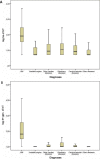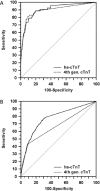High-sensitivity cardiac troponin T compared with standard troponin T testing on emergency department admission: how much does it add in everyday clinical practice?
- PMID: 23735897
- PMCID: PMC3698787
- DOI: 10.1161/JAHA.113.000204
High-sensitivity cardiac troponin T compared with standard troponin T testing on emergency department admission: how much does it add in everyday clinical practice?
Abstract
Background: We compared high-sensitivity cardiac troponin T (hs-cTnT) and standard cTnT for acute myocardial infarction (AMI) diagnosis in everyday clinical practice of an emergency department (ED).
Methods and results: cTnT was measured in 2384 consecutive patients (60 ± 21 years, 52% female) on ED admission. Readmissions to the ED (n=720) and mortality (n=101) were followed for an average period of 239 ± 49 days. There were 53 AMIs (delay, 1 to 96 hours; median, 3 hours), 440 chest pain patients, 286 dyspnea patients, 785 acute or chronic cardiac diseases, and 540 neurological diseases, with the remaining having various internal diseases. The diagnostic performances of hs- and standard cTnT were comparable for AMI diagnosis (area under receiver operating characteristics curves [ROC AUC], 0.91 ± 0.02 versus 0.90 ± 0.03; P=0.31). Using the 99th-percentile cutoff, the sensitivities and specificities for AMI in the whole population were 91% and 74% for hs-cTnT and 89% and 80% for standard cTnT. hs-cTnT detected significantly more patients with cardiac diseases (ROC AUC, 0.77 ± 0.01 versus 0.67 ± 0.01; P<0.001). hs-cTnT and standard cTnT were significant predictors of ED readmissions but not of mortality, but both were not independent predictors of ED readmissions or the combined end point of readmission or mortality in binary logistic regression analysis.
Conclusions: In unselected ED patients the diagnostic performances of hs-cTnT and standard cTnT for AMI diagnosis did not differ significantly. hs-cTnT detected significantly more cardiac diseases. hs-cTnT and standard cTnT were not independent predictors of ED readmissions and mortality from all causes.
Keywords: cardiac troponin T; diagnosis; emergency department; high sensitivity; myocardial infarction; risk stratification.
Figures



Similar articles
-
A Randomized Trial of a 1-Hour Troponin T Protocol in Suspected Acute Coronary Syndromes: The Rapid Assessment of Possible Acute Coronary Syndrome in the Emergency Department With High-Sensitivity Troponin T Study (RAPID-TnT).Circulation. 2019 Nov 5;140(19):1543-1556. doi: 10.1161/CIRCULATIONAHA.119.042891. Epub 2019 Sep 3. Circulation. 2019. PMID: 31478763 Clinical Trial.
-
Decreased admissions and hospital costs with a neutral effect on mortality following lowering of the troponin T cutoff point to the 99th percentile.Cardiol J. 2017;24(6):612-622. doi: 10.5603/CJ.a2017.0079. Epub 2017 Jul 11. Cardiol J. 2017. PMID: 28695975
-
High-Sensitivity Cardiac Troponin T in Patients with Acute Myocardial Infarction in Acute Exacerbation of Chronic Obstructive Pulmonary Disease.Clin Lab. 2015;61(8):1083-93. doi: 10.7754/clin.lab.2015.150105. Clin Lab. 2015. PMID: 26427155
-
High-sensitivity-cardiac troponin for accelerated diagnosis of acute myocardial infarction: A systematic review and meta-analysis.Am J Emerg Med. 2020 Jul;38(7):1402-1407. doi: 10.1016/j.ajem.2019.11.035. Epub 2019 Dec 28. Am J Emerg Med. 2020. PMID: 31932131
-
Measurement of Cardiac-Specific Biomarkers in the Emergency Department: New Insight in Risk Evaluation.Int J Mol Sci. 2023 Nov 6;24(21):15998. doi: 10.3390/ijms242115998. Int J Mol Sci. 2023. PMID: 37958981 Free PMC article. Review.
Cited by
-
Patient selection for high sensitivity cardiac troponin testing and diagnosis of myocardial infarction: prospective cohort study.BMJ. 2017 Nov 7;359:j4788. doi: 10.1136/bmj.j4788. BMJ. 2017. PMID: 29114078 Free PMC article.
-
Circulating micro-RNAs as biomarkers of coronary artery disease: is it ready for primetime or still a work in progress?Ann Transl Med. 2017 Jan;5(1):10. doi: 10.21037/atm.2017.01.05. Ann Transl Med. 2017. PMID: 28164095 Free PMC article. No abstract available.
-
Use of high-sensitivity troponin assays predicts mortality in patients with normal conventional troponin assays on admission-insights from a meta-analysis.Clin Cardiol. 2013 Nov;36(11):649-53. doi: 10.1002/clc.22196. Epub 2013 Aug 27. Clin Cardiol. 2013. PMID: 24037966 Free PMC article.
-
Cardiac Troponin in Patients With Light Chain and Transthyretin Cardiac Amyloidosis: JACC: CardioOncology State-of-the-Art Review.JACC CardioOncol. 2024 Feb 20;6(1):1-15. doi: 10.1016/j.jaccao.2023.12.006. eCollection 2024 Feb. JACC CardioOncol. 2024. PMID: 38510286 Free PMC article. Review.
-
High-sensitivity cardiac troponins in everyday clinical practice.World J Cardiol. 2014 Apr 26;6(4):175-82. doi: 10.4330/wjc.v6.i4.175. World J Cardiol. 2014. PMID: 24772257 Free PMC article. Review.
References
-
- Thygesen K, Alpert JS, White HDJoint ESC/ACCF/AHA/WHF Task Force for the Redefinition of Myocardial Infarction Universal definition of myocardial infarction. Eur Heart J. 2007; 28:2525-2538 - PubMed
-
- Apple FS, Jesse RL, Newby LK, Wu AH, Christenson RH, Cannon CP, Francis G, Morrow DA, Ravkilde J, Storrow AB, Tang W, IFCC Comittee on Standardization of Markers of Cardiac Damege. Jaffe AS, Mair J, Ordonez‐Llanos J, Pagani F, Panteghini M, Tate JNational Academy of Clinical Biochemistry National Academy of Clinical Biochemistry and IFCC Committee on Standardization of Markers of Cardiac Damage Laboratory Medicine Practice Guidelines: analytical issues for biochemical markers of acute coronary syndromes. Clin Chem. 2007; 53:547-551 - PubMed
-
- Saenger AK, Beyrau R, Braun S, Cooray R, Dolci A, Freidank H, Giannitsis E, Gustafson S, Handy B, Katus H, Melanson SE, Panteghini M, Venge P, Zorn M, Jarolim P, Bruton D, Jarausch J, Jaffe AS. Multicenter analytical evaluation of a high‐sensitivity troponin T assay. Clin Chim Acta. 2011; 412:748-754 - PubMed
-
- Mingels A, Jacobs L, Michielsen E, Swaanenburg J, Wodzig W, van Dieijen‐Visser M. Reference population and marathon sera assessed by highly sensitive troponin T and commercial troponin T and I assays. Clin Chem. 2009; 55:101-108 - PubMed
-
- Venge P, Johnston N, Lindahl B, James S. Normal plasma levels of cardiac troponin I measured by the high‐sensitivity cardiac troponin I access prototype assay and the impact on the diagnosis of myocardial ischemia. J Am Coll Cardiol. 2009; 54:1165-1172 - PubMed
Publication types
MeSH terms
Substances
LinkOut - more resources
Full Text Sources
Other Literature Sources
Medical
Research Materials

